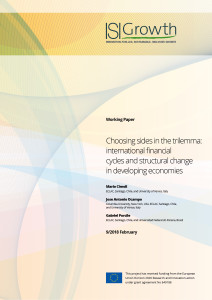This paper analyzes the impact of international financial cycles on structural change in developing economies. It is argued that the impact of these cycles depend on the specific combination of macroeconomic and industrial policies adopted by the developing economy. The cases of Brazil and Argentina are contrasted with those of Korea and China. In the Asian economies, macroeconomic policy has been a complementary tool along with industrial policy to foster the diversification of production and capabilities. Inversely, in the case of the Latin American countries, long periods of real exchange rate (RER) appreciation, combined with the weaknesses (or absence) of industrial policies, gave rise to loss of capabilities and lagging behind. Tests of structural break in times series of indexes of technological intensity of the production structure confirm the long run effects of financial shocks in the Latin American case. In the case of Korea there is evidence of hysteresis à la Baldwin-Krugman: a high RER was initially required to export and diversity the economy, but it was no longer necessary when the country had already built indigenous capabilities.
Choosing sides in the trilemma: international financial cycles and structural change in developing economies
Mario Cimoli
ECLAC, Santiago, Chile, and University of Venice, Italy
Jose Antonio Ocampo
Columbia University, New York, USA, ECLAC, Santiago, Chile, and University of Venice, Italy
Gabriel Porcile
ECLAC, Santiago, Chile, and Universidad Federal do Parana, Brasil

